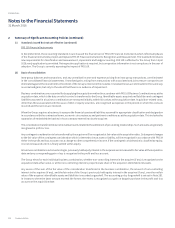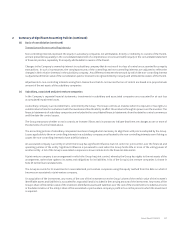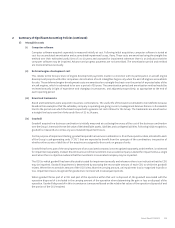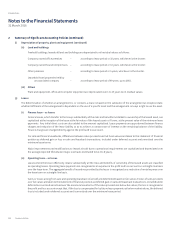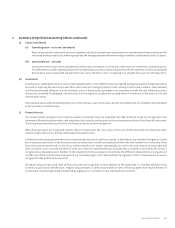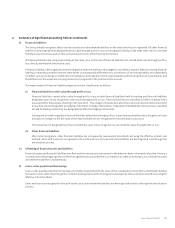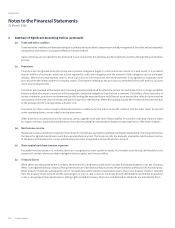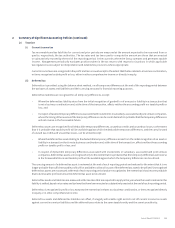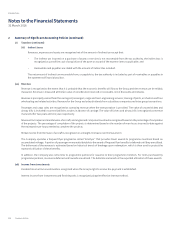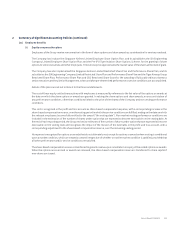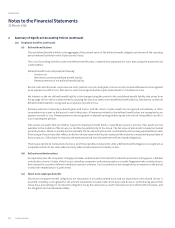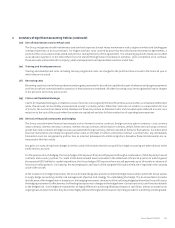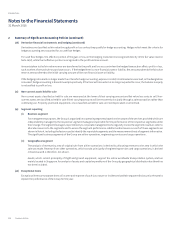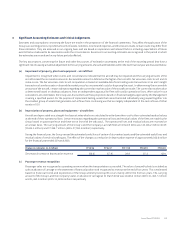Singapore Airlines 2016 Annual Report Download - page 127
Download and view the complete annual report
Please find page 127 of the 2016 Singapore Airlines annual report below. You can navigate through the pages in the report by either clicking on the pages listed below, or by using the keyword search tool below to find specific information within the annual report.2 Summary of Significant Accounting Policies (continued)
(o) Cash and cash equivalents
Cash and cash equivalents comprise cash on hand, deposits in banks and short-term, highly liquid investments that are readily convertible
to known amounts of cash and which are subject to an insignificant risk of changes in value, and are used by the Group in the management
of its short-term commitments.
The accounting policy for this category of financial assets is stated in Note 2(l), under loans and receivables.
(p) Impairment of non-financial assets
The Group assesses at each reporting date whether there is an indication that an asset may be impaired. If any such indication exists, or
when annual impairment assessment for an asset is required, the Group makes an estimate of the asset’s recoverable amount.
An asset’s recoverable amount is the higher of an asset’s or CGU’s fair value less costs to sell and its value-in-use and is determined for
an individual asset, unless the asset does not generate cash inflows that are largely independent of those from other assets or groups of
assets. In assessing value-in-use, the estimated future cash flows expected to be generated by the asset are discounted to their present
value using a pre-tax discount rate that reflects current market assessments of the time value of money and the risks specific to the asset.
Where the carrying amount of an asset or its related CGU exceeds its recoverable amount, the asset is considered impaired and is written
down to its recoverable amount.
For non-financial assets excluding goodwill and those with indefinite lives, an assessment is made at each reporting date as to whether
there is any indication that previously recognised impairment losses may no longer exist or may have decreased. If such indication exists,
the Group estimates the asset’s or CGU’s recoverable amount. A previously recognised impairment loss is reversed only if there has been
a change in the estimates used to determine the asset’s recoverable amount since the last impairment loss was recognised. If that is the
case, the carrying amount of the asset is increased to its recoverable amount. That increase cannot exceed the carrying amount that
would have been determined, net of depreciation, had no impairment loss been recognised previously. Such reversal is recognised in the
profit and loss account unless the asset is measured at revalued amount, in which case the reversal is treated as a revaluation increase.
(q) Impairment of financial assets
A financial asset not carried at fair value through profit or loss, including an interest in an associated and joint venture company, is assessed
at the end of each reporting period to determine whether there is objective evidence that it is impaired. A financial asset is impaired if
objective evidence indicates that a loss event has occurred aer the initial recognition of the asset, and that the loss event has an impact
on the estimated future cash flows of that asset that can be estimated reliably.
(i) Financial assets carried at amortised cost
For financial assets carried at amortised cost, the Group first assesses whether objective evidence of impairment exists individually
for financial assets that are individually significant, or collectively for financial assets that are not individually significant. If the
Group determines that no objective evidence of impairment exists for an individually assessed financial asset, whether significant
or not, it includes the asset in a group of financial assets with similar credit risk characteristics and collectively assesses them for
impairment. Assets that are individually assessed for impairment and for which an impairment loss is, or continues to be, recognised
are not included in a collective assessment of impairment.
In assessing collective impairment, the Group uses historical trends of the probability of default, the timing of recoveries and the
amount of loss incurred, adjusted for management’s judgement as to whether current economic and credit conditions are such
that the actual losses are likely to be greater or less than suggested by historical trends.
If there is objective evidence that an impairment loss on financial assets carried at amortised cost has been incurred, the amount
of the loss is measured as the dierence between the asset’s carrying amount and the present value of estimated future cash flows
(excluding future credit losses that have not been incurred) discounted at the financial asset’s original eective interest rate. The
carrying amount of the asset is reduced either directly or through the use of an allowance account. The impairment loss is recognised
in the profit and loss account.
Annual Report FY2015/16 125



